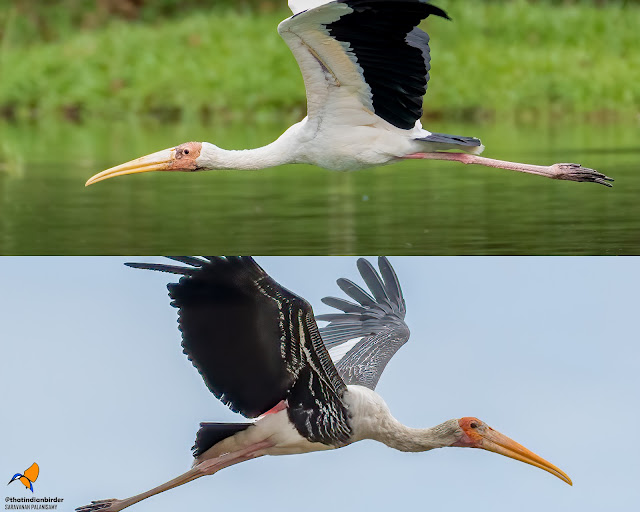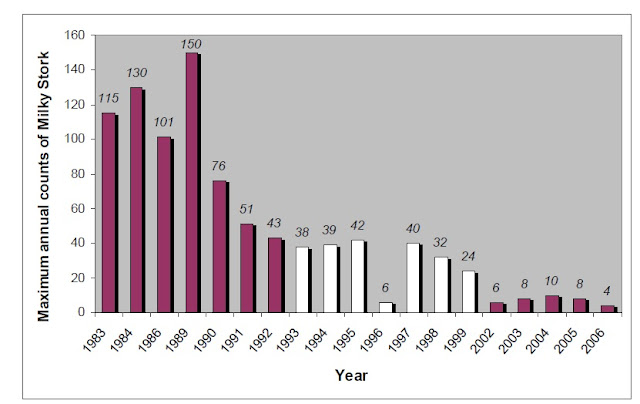Name: Milky Stork
Scientific Name: Mycteria cinerea
Local (Malay) Name: Burung Botak Upih / Burung Upih / Upih Bakau
Measurement: 91 - 97 cm
Milky Stork is a stork species mainly found at the coastal mangroves of some South East Asian countries. Earlier was grouped under the genus "Ibis", later it was placed under the genus "Mycteria" as for their similarities with other stork species in the genus. The term "Mycteria" means snout or "nose" in Ancient Greek; "cinerea" means "ashy coloured" in Latin, which is rather confusing as this stork appears white. There are cases whereby the term "cinerea" being used for describing "whitish" colours of some plants and animals as well.
"This species was first known to me through in 1996 my first bird guide book "Pengenalan Burung-Burung Malaysia" published by World Wide Fund for Nature Malaysia (1989). It was described that the population of Milky Stork is rapidly declining and the last strong hold is Kuala Gula sanctuary. At that time, I was in doubt whether I would be able to see this bird in the wild before its too late."
Description:
Milky Storks are slightly smaller than Painted Storks. Adult storks appear in white with black flight feathers and tails. Bare facial skin is orange-red with irregular black blotches. Bill is yellow. During breeding season, the facial skin appears in wine red color, which fades to its original color soon after the courtship. Bill turns into deep yellow and legs will be in deep magenta during the courtship. Immature birds look similar to those of Painted Storks. Head, neck and wing coverts are pale brown, with darker flight feathers and tail. Hybridization due occur, mostly recorded in captivity. The hybrids of Milky and Painted storks, with some black markings on their upper wing coverts and lacks the pinkish tinge on its tertial and inner secondary feathers. Some has much paler upper wings compared to those Painted Storks.
 |
| A free ranging Milky Stork at Taiping Lake Garden |
 |
| Immature Milk Stork |
Status and Distribution:
Uncommon localized resident of Peninsular Malaysia. Kuala Gula (Perak) sanctuary was its stronghold once. Free ranging Milky Storks can be seen at Taiping Lake Garden (Perak), as a result of successful breeding program done by Taiping Zoo. Milky Storks are also seen in small numbers (mostly flock along with Painted Storks) at Johor (Tanjung Piai, and Sungai Danga), Selangor (Shah Alam Lake Garden), Kuala Lumpur, Putrajaya and Malacca (Sungai Putat).
Confusion Species:
Milky Storks can be at times confused with its close relative, the Painted Stork. This was seen in some recorded observation in some webpages. Milky Storks lacks the black markings on its wing coverts and the pinkish tinge on its tertial feathers of Painted Storks. Underwing plumage also different from those Painted Storks; Painted Stork's flight feathers are black, with black and white markings on lesser and median underwing coverts which cross over its chest. As for Milky Storks, the lesser and median underwing coverts are white. In side by side comparison, Milky Storks appear smaller than Painted Storks.
 |
| Comparison between the underpart of Milky Stork (Top) and Painted Stork (Bottom) |
Geographical Variation:
None. Monotypic
Behavior:
Moves and forages in flocks. Also flocks along with Painted Storks. Fish is their main diet. Those Milky Storks occurs along coastal mangroves are recorded to consume mainly on mudskippers. The storks found at Taiping Lake Garden were seen taking fish along with small snakes and frogs. Preys are captured by sense of touch and also by visual searching. Hunting mechanisms of Milky Storks that had been observed are:
1. Groping - It walks slowly through shallow water while the bill is submerged partially in the water, often draw its bill in an arc side to side. It then rapidly shuts the mandibles as soon as the prey touches the groping bill. This typical hunting method is also known as "active tactolocation". Sometime the stork stands stationary, waiting for the prey to make contact with its opened mandibles, which is termed as "passive tactolocation".
2. Direct Probing - With partially opened mandibles, the bill is directly probed into holes on mudflats to capture prey in the mud.
3. Prey Herding - Milky Storks also cooperatively flush prey into shallower water in flocks, which adds more success rate in their hunt. It uses its feet to "agitate" and drive out the fish from its hide at the water edge, which later captured in between its gaped bill.
Once captured, the prey is swallowed whole after some tossing.
 |
| Groping for prey |
 |
| A Milky Stork stirring the grasses with its feet at the water edge to drive the prey out from its hide |
Habitat:
Coastal mangroves with tidal mudflats, and estuaries.
Breeding:
Breeding typically occurs from April to November. In Taiping, free ranging Milky Storks are recorded to breed from March to August. It breed colonially, along with other species as well at the matured mangroves. Tall, dead mangrove trees (mostly Avicennia sp.) are chosen for nesting. Courtship display is done by bowing and bill raising. Nest is built with medium live sticks of mangrove species. Typically 2 to 3 eggs are laid, incubated for 30 days. It takes approximately 50 days for the chicks to fledge.
Hybrids:
Recorded to breed with Painted Storks (Mycteria leucocephala) and Lesser Adjutant (Leptoptilos javanicus) in captivity. 2 to 3 hybrids (Milky Stork x Painted Stork) found at Tanjung Ketapang coast of Johor by Ahmad Taufik on October 2022
%20(1).jpg) |
| Milky Stork x Painted Stork Hybrid at Tanjung Ketapang, Johor. (Photo by: Ahmad Taufik) |
Conservation Status:
Classified as "Endangered" under IUCN Red List of Threatened Species. Census for Milky Storks were started in 1983 at Matang Mangrove Forest. Perak Forestry Department classified two areas within Matang Mangrove Forest; Pulau Kalumpang Lake and Pulau Terong Lake as main conservation ground for the Milky Storks. Despite of all effort taken by the government, the population of Milky Stork rapidly declined, from 150 individual in 1980s to less than 10 storks, in 20 years. In 1935, a breeding colony of these storks existed in Pulau Ketam (Selangor), which later wiped out by human interference (i.e. poaching). Currently, only 5 wild Milky Storks had been seen so far at Matang Mangrove Forest and it has become more and more uncommon now. Among the factors that had contributed to its population decline in the wild were:
a. unsuccessful breeding due to the decrease of larger, matured trees at the coastal mangroves.
b. higher population density of predators, which leads to higher chances of egg and nestling predation (i.e. Brahminy Kite, White Bellied Sea Eagle, Asian Water Monitor, Common Palm Civets, Long Tailed Macaque).
c. human interference, through mangrove wood harvesting, pollution and the presence of human itself at the habitat/nesting site of the storks (due to fishing, hunting and other forestry activities), since Milky storks are very sensitive to disturbance.
d. migrated to other locations due to lack of prey items and suitable nesting area
 |
| Population Trend of Milk Storks at Matang Mangrove Forest from 1983 to 2006 |
As a respond to the declining population of Milky Storks, PERHILITAN along with Zoo Negara and Malaysian Nature Society (MNS) initiated "Milky Stork Breeding and Reintroduction Program" in the late 1980s. This is to achieve a free flying population of Milky Storks at Kuala Selangor Nature Park (KSNP) and also to re-establish the storks at other sites at the coastal mangroves of Selangor. The program was made into two phase:
a. Phase 1 (between 1987 to 1996) - to build up stock of breeding storks in Zoo Negara.
b. Phase 2 (between 1996 to 2004) - to release the storks (2nd generation) in the on-site aviary built in KNSP.
A total of 10 storks (3 males and 7 females) were obtained from Zoo Negara and released in the aviary of KNSP. Nests were seen but the breeding was unsuccessful (eggs hatched but no young fledged). It was decided to release all the storks after one of them escaped the aviary through a tear in the aviary netting.
The free flying storks later began courtship and 3 nest were found within a Grey Heron colony at KNSP. From a total of 6 eggs, 5 chicks hatched. 3 dies within few days, and the last 2 were killed when the nest was toppled by storm. As in 2004, 4 storks were regularly seen at coast of Sungai Buloh by bird watchers so far.
The program later was discontinued due to lack of funding to maintain the aviary as well as to feed and monitor the storks. Lack of expertise in behavior and breeding biology of those storks is mentioned to be another reason for the program to be unsuccessful.
Even though the wild population had decline rapidly, the number of captive and free ranging Milky Storks has steadily risen. Zoo Negara had over 224 individuals in 2007, resulted by captive breeding program initiated in the year 1987 (Phase 1 of "Milky Stork Breeding and Reintroduction Program"), with 10 Milky Storks.
Currently we can see a good population of Milky Storks wandering around Taiping Lake Garden, as a result of successful breeding of free ranging storks at Taiping Zoo. The lakes adjacent to the zoo provides food for these free flying birds. However the storks still has to return to the zoo for nesting. Tall trees within the zoo compound provides a safer nesting area for the storks, against predation. So far there are 34 free flying Milky Storks around Taiping Zoo area.
Another issue that can lead Milky Storks to extinction is hybridization. When an endangered species hybridizes with closely related species, it might get absorbed into that species. There is record of the Milk Stork x Painted Stork hybrids escaped from captivity into the wild and interbred with wild birds. Therefore, the population of "pure" Milky Storks in the wild will be lesser as time goes on, until it is totally extinct. As for this, strict removal of hybrids from the wild along with the introduction of genetically pure Milky Storks ensures the species survival.
References:
1. David Li Zuo Wei, Siti Hawa Yatim, John Howes and Rahmah Ilias (2006) Status Overview and Reccomendations for the Conservation of Milky Strok Mycteria cinerea in Malaysia,
Wetland Internation & Dept of Wildlife and National Parks, Peninsular Malaysia.
2. Wikipedia, 2017. "Milky Stork". Last Modified March 4, 2017.
3. Dr. Kevin Lazarus (Taiping Zoo and Night Safari), Nov 16, 2021.





%20(1).jpg)


No comments:
Post a Comment